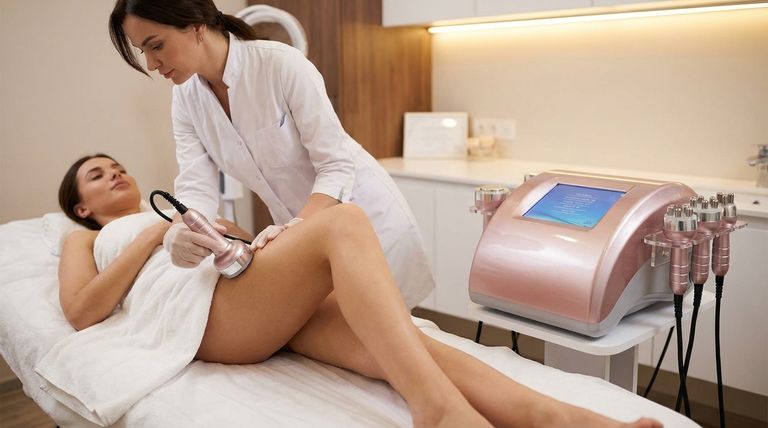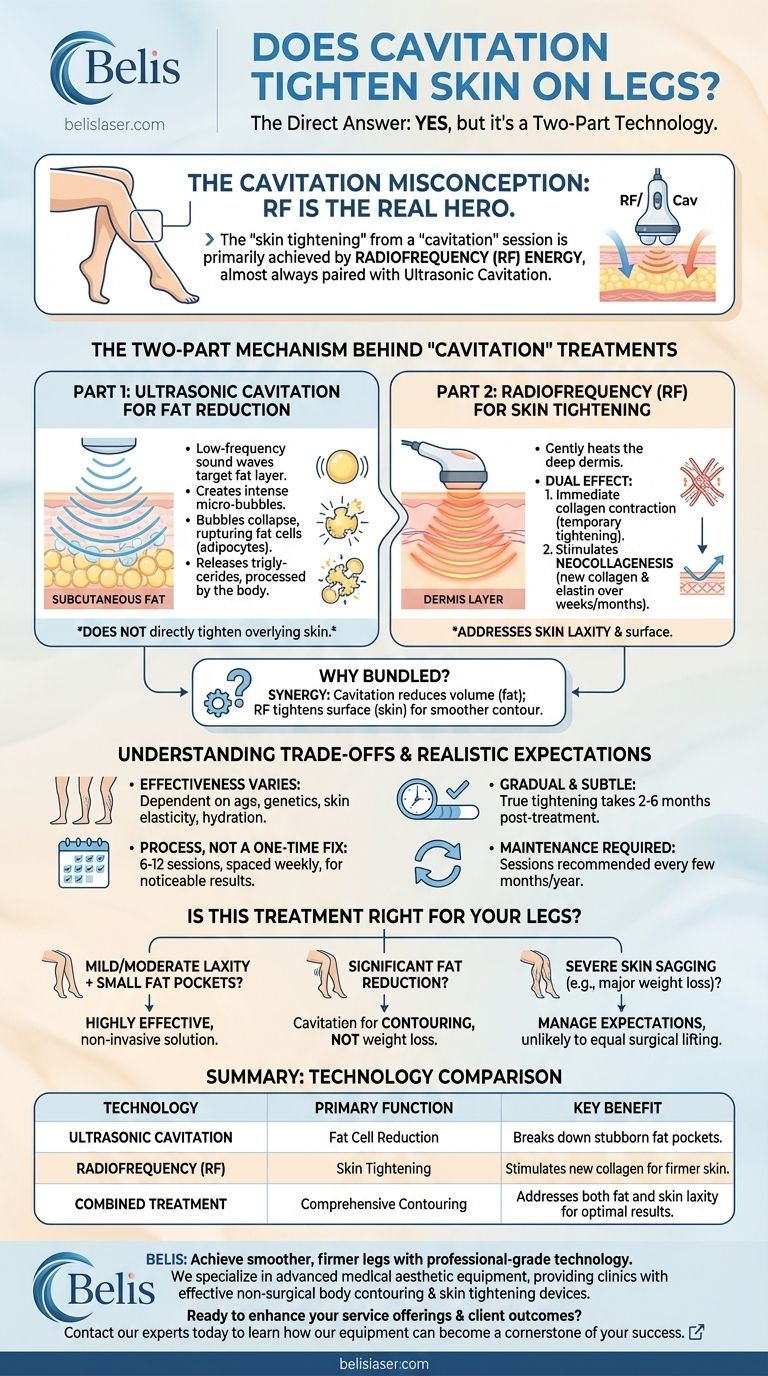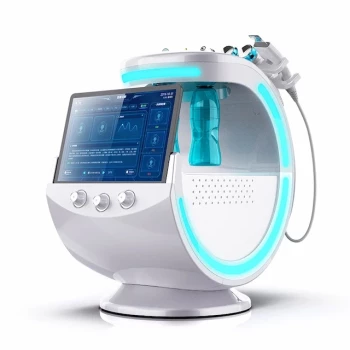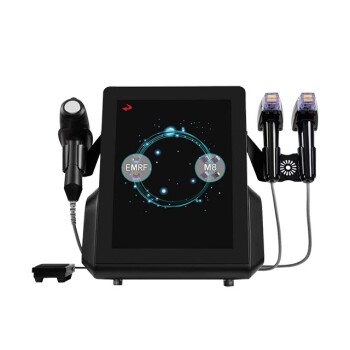To be direct, yes, treatments marketed as "cavitation" can result in tighter-looking skin on the legs. However, the term itself is often a shorthand for a combined therapy, and the "cavitation" part is not what's directly responsible for tightening the skin. Understanding the two distinct technologies at play is critical to setting realistic expectations.
The "skin tightening" effect you're seeking from a "cavitation" session is primarily achieved by Radiofrequency (RF) energy, which is almost always paired with the Ultrasonic Cavitation used for fat reduction. Cavitation addresses the fat; RF addresses the skin.

The Two-Part Mechanism Behind "Cavitation" Treatments
A typical body contouring session marketed as "cavitation" leverages two different technologies in sequence to achieve a comprehensive result. Confusing them as one process is a common misunderstanding.
Part 1: Ultrasonic Cavitation for Fat Reduction
Ultrasonic cavitation uses low-frequency sound waves to target the subcutaneous fat layer beneath your skin.
These sound waves create intense vibrations, causing micro-bubbles to form within the interstitial fluid. When these bubbles collapse, the resulting shockwave ruptures the membrane of nearby fat cells (adipocytes).
The contents of the fat cell—triglycerides—are then released and processed by the body's lymphatic and metabolic systems. This process reduces the volume of localized fat deposits but does not directly tighten the overlying skin.
Part 2: Radiofrequency (RF) for Skin Tightening
This is the component that actually addresses skin laxity. After cavitation, a provider will use a radiofrequency (RF) device on the same area.
RF energy works by gently heating the deeper layer of your skin, the dermis. This controlled thermal energy has a dual effect.
First, it causes the existing collagen fibers to contract, creating an immediate, though temporary, tightening effect. More importantly, this thermal stress signals the body to begin a healing response, which involves producing new, healthy collagen and elastin over the following weeks and months. This process is known as neocollagenesis.
Why They Are Bundled Together
The synergy between these two technologies is why they are so often sold as a single package. Reducing fat volume with cavitation can sometimes leave the skin slightly more lax than before.
Following up with RF energy helps to tighten and firm that skin, leading to a smoother, more contoured final appearance. One addresses the volume, the other addresses the surface.
Understanding the Trade-offs and Realistic Expectations
While this combination can be effective, it is not a magic wand. Objectivity is crucial when considering this treatment.
Effectiveness Varies by Individual
Results are highly dependent on your age, genetics, the initial degree of skin laxity, and lifestyle factors. Younger individuals with good skin elasticity who are well-hydrated will typically see better results than older individuals with significant sun damage or poor elasticity.
This Is a Process, Not a One-Time Fix
A single session will not produce a lasting or dramatic change. A typical protocol involves 6 to 12 sessions, often spaced about a week apart, to achieve a noticeable improvement.
The Results Are Gradual and Subtle
The true skin tightening from new collagen production takes time—often 2 to 6 months after your final session to see the full effect. The results are subtle and are not comparable to a surgical procedure like a thigh lift.
Maintenance Is Often Required
The natural aging process continues, so maintenance sessions are typically recommended every few months to a year to preserve the results of your initial treatment series.
Is This Treatment Right for Your Legs?
To make the right choice, you must align the technology's capabilities with your specific goal.
- If your primary focus is mild to moderate skin laxity combined with small, stubborn fat pockets: This combination treatment can be a highly effective, non-invasive solution.
- If your primary focus is significant fat reduction: Cavitation can help contour and reduce inches, but it is not a weight-loss treatment and is best for localized areas.
- If your primary focus is severe skin sagging (e.g., after major weight loss): You must manage your expectations, as this treatment is unlikely to provide the dramatic lifting effect of a surgical procedure.
Understanding the distinct roles of cavitation and radiofrequency empowers you to have a more informed discussion with your provider and set realistic goals for your treatment.
Summary Table:
| Technology | Primary Function | Key Benefit |
|---|---|---|
| Ultrasonic Cavitation | Fat Cell Reduction | Breaks down stubborn fat pockets for contouring. |
| Radiofrequency (RF) | Skin Tightening | Stimulates new collagen for firmer, tighter skin. |
| Combined Treatment | Comprehensive Body Contouring | Addresses both fat and skin laxity for optimal results. |
Achieve smoother, firmer legs with professional-grade technology.
At BELIS, we specialize in advanced medical aesthetic equipment, providing clinics and premium beauty salons with the most effective devices for non-surgical body contouring and skin tightening. Our solutions combine proven technologies like Radiofrequency and Ultrasonic Cavitation to deliver safe, noticeable results for your clients.
Ready to enhance your service offerings and client outcomes? Contact our experts today to learn how our equipment can become a cornerstone of your success.
Visual Guide

Related Products
- Ultrasonic Cavitation Radiofrecuency Machine for Body Slimming
- Cryolipolysis Fat Freezing Machine and Ultrasonic Cavitation Device
- 4D 12D HIFU Machine Device for Skin Tightening
- 12D HIFU Machine Device for Facial HIFU Treatment
- Cryolipolysis Fat Freezing Machine Ultrasonic Cavitation Fat Reducing Device
People Also Ask
- Does ultrasound really break down fat? Discover the Science of Non-Invasive Fat Reduction
- Does cavitation get rid of belly fat? Yes, Here's How It Works for Body Sculpting
- When should you not use a cavitation machine? Critical Safety Guidelines for Aesthetic Treatments
- What are the restrictions for cavitation? Ensure Your Safety and Treatment Success
- Does cavitation destroy fat cells permanently? Yes, for targeted, stubborn fat reduction.



















